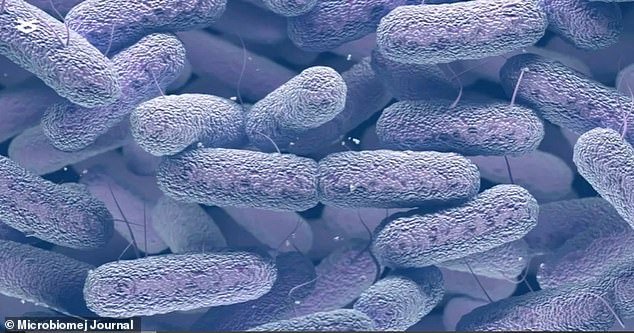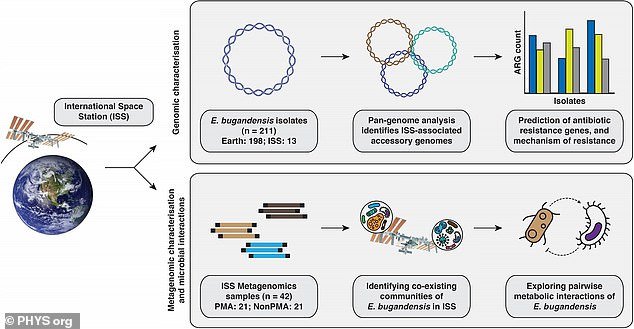NASA finds new mutant bacteria in SPACE
It may sound like the plot of a new Alien movie, but NASA has found a mutated bacteria that thrives in space.
Researchers discovered 13 strains of the bacteria called Enterobacter bugandensis, which is linked to blood infections on the International Space Station (ISS), which could endanger the health of astronauts on board.
The extreme environment on the ISS, such as higher carbon dioxide levels, forced the bacteria to mutate, and when exposed to microgravity the bacteria can become resistant to antibiotics.
The bacteria hitched a ride on astronauts to the orbiting laboratory and now on researchers have warned that microgravity could affect their health, making them more susceptible to infections from the bacteria.
The International Space Station was built in 1998 and has housed 300 astronauts over the past twenty years. Scientists have now discovered a mutated bacterium that could pose a harmful risk to astronauts

A mutated form of the bacterium E. bugandensis (pictured) was found on the ISS and developed drug resistance. The bacteria has been linked to sepsis in infants and life-threatening infections that can cause inflammation of the lining of the heart’s chambers and valves.
The mutation placed the bacteria in the ESKAPE pathogen group – bacteria that are the leading cause of infections acquired while receiving medical care.
The bacteria has been linked to serious infections, such as a blood infection found in infants called neonatal sepsis.
Enterobacter infections can also lead to sepsis, urinary tract infections, skin and soft tissue infections, and endocarditis – life-threatening inflammation that occurs on the lining of the heart chambers and valves.
Researchers first discovered microorganisms living among astronauts in 2019 during an extensive survey of fungi and bacteria living on the ISS, but recently identified the lead bacteria as E. bugandensis.
The team identified thirteen bacterial strains at three locations on the ISS: four in the air circulation system, one on an exercise machine and eight in the laboratory bathroom.

Researchers have put together an illustration showing the process they used to analyze E. bugandensis and evaluate how it adapts in the ISS habitat (photo)
During their research, scientists took three steps to identify the bacteria’s mutation, rather than just comparing the E. bugandensis found on the ISS to the variation found on Earth.
First, the team analyzed how the bacterium’s genome and its functionality changed as it adapted to the extreme environment of space, before moving to the second step, identifying the abundance of the E. bugandensis population on the ISS.
Finally, they looked at the bacteria’s metabolic interactions that benefit other microorganisms, allowing them to survive and grow.
“Research shows that under stress, isolated strains from the ISS mutated and became genetically and functionally distinct from their counterparts on Earth,” NASA reported.
“The strains were able to persist in significant quantities on the ISS over time,” it added.
“The ISS genomes showed an average of 4,568 genes, a significantly higher number than the average of 4,416 genes found in Earth’s genomes,” the team shared in the study.
Researchers found that the mutant strains also had completely different genes that may have accounted for their multidrug-resistant properties.
Although a variant of E. bugandensis exists on Earth, the environment aboard the space station provided extreme conditions such as microgravity (very low or weak gravity), solar radiation and elevated carbon dioxide levels that forced the bacteria to mutate to survive.
Other factors such as ventilation, humidity and air pressure may have helped E. bugandensis thrive, the study said, adding that the bacterial strain could coexist with other microorganisms on the ISS and may have contributed to their survival.
Scientists say that by studying how microorganisms survive in extreme environments on the ISS, “this research opens doors to effective preventive measures for astronaut health.”
